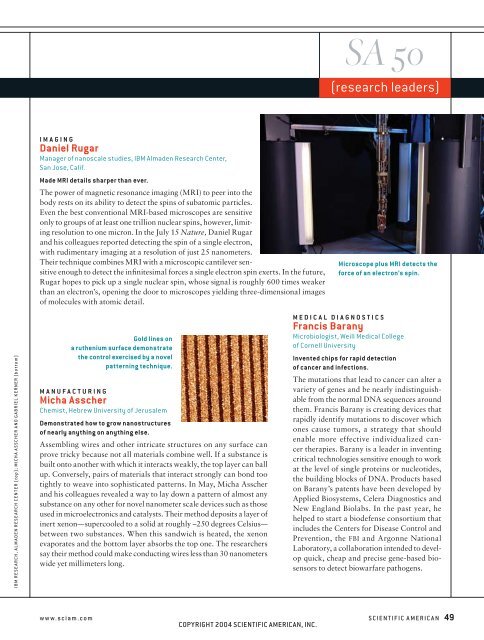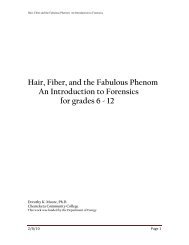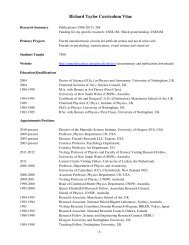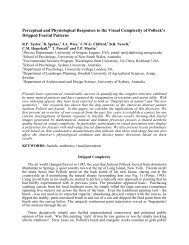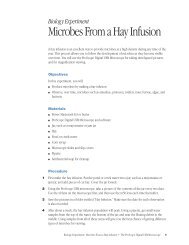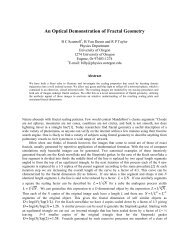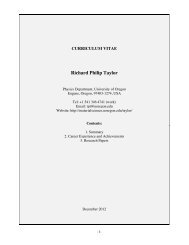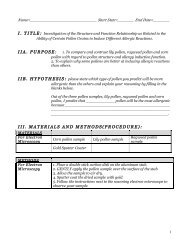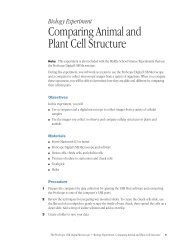December 2004 - Materials Science Institute - University of Oregon
December 2004 - Materials Science Institute - University of Oregon
December 2004 - Materials Science Institute - University of Oregon
Create successful ePaper yourself
Turn your PDF publications into a flip-book with our unique Google optimized e-Paper software.
IBM RESEARCH, ALMADEN RESEARCH CENTER (top); MICHA ASSCHER AND GABRIEL KERNER (bottom)<br />
IMAGING<br />
Daniel Rugar<br />
Manager <strong>of</strong> nanoscale studies, IBM Almaden Research Center,<br />
San Jose, Calif.<br />
Made MRI details sharper than ever.<br />
The power <strong>of</strong> magnetic resonance imaging (MRI) to peer into the<br />
body rests on its ability to detect the spins <strong>of</strong> subatomic particles.<br />
Even the best conventional MRI-based microscopes are sensitive<br />
only to groups <strong>of</strong> at least one trillion nuclear spins, however, limiting<br />
resolution to one micron. In the July 15 Nature, Daniel Rugar<br />
and his colleagues reported detecting the spin <strong>of</strong> a single electron,<br />
with rudimentary imaging at a resolution <strong>of</strong> just 25 nanometers.<br />
Their technique combines MRI with a microscopic cantilever sensitive<br />
enough to detect the infi nitesimal forces a single electron spin exerts. In the future,<br />
Rugar hopes to pick up a single nuclear spin, whose signal is roughly 600 times weaker<br />
than an electron’s, opening the door to microscopes yielding three-dimensional images<br />
<strong>of</strong> molecules with atomic detail.<br />
Gold lines on<br />
a ruthenium surface demonstrate<br />
the control exercised by a novel<br />
patterning technique.<br />
MANUFACTURING<br />
Micha Asscher<br />
Chemist, Hebrew <strong>University</strong> <strong>of</strong> Jerusalem<br />
Demonstrated how to grow nanostructures<br />
<strong>of</strong> nearly anything on anything else.<br />
Assembling wires and other intricate structures on any surface can<br />
prove tricky because not all materials combine well. If a substance is<br />
built onto another with which it interacts weakly, the top layer can ball<br />
up. Conversely, pairs <strong>of</strong> materials that interact strongly can bond too<br />
tightly to weave into sophisticated patterns. In May, Micha Asscher<br />
and his colleagues revealed a way to lay down a pattern <strong>of</strong> almost any<br />
substance on any other for novel nanometer scale devices such as those<br />
used in microelectronics and catalysts. Their method deposits a layer <strong>of</strong><br />
inert xenon—supercooled to a solid at roughly –250 degrees Celsius—<br />
between two substances. When this sandwich is heated, the xenon<br />
evaporates and the bottom layer absorbs the top one. The researchers<br />
say their method could make conducting wires less than 30 nanometers<br />
wide yet millimeters long.<br />
SA 50<br />
(research leaders)<br />
Microscope plus MRI detects the<br />
force <strong>of</strong> an electron’s spin.<br />
MEDICAL DIAGNOSTICS<br />
Francis Barany<br />
Microbiologist, Weill Medical College<br />
<strong>of</strong> Cornell <strong>University</strong><br />
Invented chips for rapid detection<br />
<strong>of</strong> cancer and infections.<br />
The mutations that lead to cancer can alter a<br />
variety <strong>of</strong> genes and be nearly indistinguishable<br />
from the normal DNA sequences around<br />
them. Francis Barany is creating devices that<br />
rapidly identify mutations to discover which<br />
ones cause tumors, a strategy that should<br />
enable more effective individualized cancer<br />
therapies. Barany is a leader in inventing<br />
critical technologies sensitive enough to work<br />
at the level <strong>of</strong> single proteins or nucleotides,<br />
the building blocks <strong>of</strong> DNA. Products based<br />
on Barany’s patents have been developed by<br />
Applied Biosystems, Celera Diagnostics and<br />
New England Biolabs. In the past year, he<br />
helped to start a biodefense consortium that<br />
includes the Centers for Disease Control and<br />
Prevention, the FBI and Argonne National<br />
Laboratory, a collaboration intended to develop<br />
quick, cheap and precise gene-based biosensors<br />
to detect biowarfare pathogens.<br />
www.sciam.com SCIENTIFIC AMERICAN 49<br />
COPYRIGHT <strong>2004</strong> SCIENTIFIC AMERICAN, INC.


